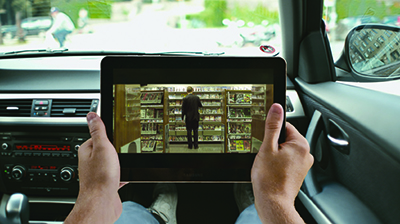Cisco Survey Touts Mobile Video Boom

Gary Arlen
BETHESDA, MD.--Cisco System’s annual Visual Networking Index anticipates an array of opportunities for mobile and wireless delivery, including vast expansion of mobile video services and multiscreen ventures. It also serves as strong ammunition for forces who want to seize spectrum for the growing global demand for mobile bandwidth.
The VNI Global Mobile Data Traffic Forecast, issued just before last month’s Mobile World Congress in Barcelona, envisions that video will constitute two-thirds of the world’s mobile data traffic by 2017, a 16- fold increase between now and then. The mobile video load will far exceed other mobile data usage, such as email, Web surfing and machine-to-machine services in the “Internet of Everything.”
Mobile video traffic accounted for 51 percent of the worlds’ Internet traffic at the end of 2012, the first time video took up more than half of all wireless bandwidth, Cisco says.
Several recent analyses and product announcements at the Barcelona mobile trade show underscore Cisco’s great expectations. For example, Parks Associates, a Texas market research firm, singles out the rapid increase of video viewing on tablets and smartphones, and Ericsson was among the technology suppliers to launch new multiplatform capabilities during the Mobile World Congress.
INDUSTRY BENCHMARK
The annual Cisco outlook, which is intended to gauge Internet traffic to identify where and when network hardware will be needed, has become an industry benchmark. In the last few years it has increasingly focused on wireless appetites. About four years ago, the Cisco VNI forecast for wired networks began to cite the dominance of video via Internet Protocol as the dominant factor in overall bandwidth consumption—and the need to expand network capacity to handle it.

In its latest outlook, Cisco focuses on the growing roles of smartphones and tablets, predicting that more viewers around the world will have access to two-screen TV services if they want to use them. And Cisco singles out a finding from its most recent “Data Meter” tally during the last four months of 2012 in which the greatest use of tablets and smartphones was for watching video.
“Video streaming and communications applications such as YouTube, Hulu, and Netflix ranks highest on both device platforms,” Cisco explains in its report. Half of tablet data consumption was for video/ communications service, as was 45 percent of smartphone traffic. Those usage levels far outpaced “information” content (such as maps and news headlines: 17 percent on tablets and 12 percent on smartphones), Web browsing (7 percent and 6 percent, respectively), social networking (3 percent and 7 percent) or music/audio streaming (3 percent on tablets, 4 percent on smartphones)
Among the many interpretations of this data is that simultaneous two-screen video experiences may become less relevant if substantial viewing is already taking place on a handheld device.
That prospect bubbles up in Parks Associates report on “Mobile Video: The Next Pay Tv Battlefront.” The study looks at the growing competition from over-the-top video services as well as shifting viewing preferences as consumers can watch video on multiple screen options.
“Smartphones and tablets will be key battlegrounds in the fight between traditional pay TV providers and over-the-top providers,” says John Barrett, director of consumer analytics at Parks. The study confirms Cisco’s tally about the increasing video consumption on tablets, smartphones and computers (desktop and especially laptops) during the past two years. Significantly, the analysis shows that in houses equipped with broadband, “occasional viewers” (people who tune in fewer than 15 times per month), are watching less on conventional TV sets but spending significantly more viewing time on tablets, handsets and computers. The Parks study also reflects data from Nielsen and others, that TV set viewing is climbing slightly, but not at the velocity of alternatives.
“Netflix currently dominates three of the four screens consumers use to watch movies and TV programs,” adds Barrett. “It is crucial for pay TV providers to establish a strong mobile video presence as part of their overall strategy to counter OTT.”
ENABLING THE MULTISCREEN MIGRATION
As options expand, infrastructure providers are preparing for the IP video future that Cisco’s forecasts portend. For example, at the Mobile World Conference, Ericsson unveiled its unified content delivery network (CDN), which it says can “unite the delivery of managed and unmanaged video content over fixed and mobile networks.”
Ericsson’s platform recognizes that the movement toward on-demand and other OTT content require high-quality video and the optimization of what Ericsson calls “traffic over multiple CDNs via a single CDN selection technology.”
The company claims that its “Ericsson Media Delivery Network” will serve the needs of content providers and operators throughout the media value chain.
“Internet traffic is growing with exponential force and becoming dominated by video,” says an Ericsson statement, reflecting the Cisco and other findings. “These disruptive trends are true game-changers for our customers.’
The company says its Media Delivery Network is “designed to enable operators to [handle]the rapid growth in managed and unmanaged content, especially the massive growth in Over-The-Top services and applications, which can present network operators with several challenges.” It cites high peering costs, expensive backhaul transit, “last-mile” bandwidth competition and declining subscription revenues.
Ericsson claims that its “end-to-end business solution …enables operators to …leverage their established consumer relationship; while at the same time offering content providers and enterprises cost-effective accessibility and guaranteed quality of experience across mobile and fixed networks.”
Reflecting the evolving multiscreen delivery environment, the company is also emphasizing that the “multiservice architecture allows expansion to different CDN applications,” including Web acceleration, gaming and other IP utilities.
Other vendors in Barcelona were expected to introduce similar products to feed the needs of wired and wireless operators who are scrambling to keep up with the multiplatform juggernaut.
Hence Cisco’s VNI outlook becomes a self-fulfilling prophecy as well as an important roadmap for the future of delivery, especially the dominant video ingredient. For example, Cisco expects that by 2017, mobile-connected tablets will receive and generate more traffic than the entire global mobile network in 2012. And for historic comparison, Cisco notes that mobile data traffic last year was nearly 12 times the size of the entire global Internet in 2000.
Cisco is equally specific as it looks ahead, stipulating that, “The amount of [global] mobile data traffic generated by tablets in 2017 [1.3 exabytes per month] will be 1.5 times higher than the total amount of global mobile data traffic in 2012 [885 petabytes per month].”
Those figures include a lot of video. In fact, just measuring in exabytes (each equivalent to a billion gigabytes or a million terabytes) is a reminder of how big and how fast this multiplatform evolution really is taking shape.
Get the TV Tech Newsletter
The professional video industry's #1 source for news, trends and product and tech information. Sign up below.
Gary Arlen, a contributor to Broadcasting & Cable, NextTV and TV Tech, is known for his visionary insights into the convergence of media + telecom + content + technology. His perspectives on public/tech policy, marketing and audience measurement have added to the value of his research and analyses of emerging interactive and broadband services. Gary was founder/editor/publisher of Interactivity Report, TeleServices Report and other influential newsletters; he was the long-time “curmudgeon” columnist for Multichannel News as well as a regular contributor to AdMap, Washington Technology and Telecommunications Reports; Gary writes regularly about trends and media/marketing for the Consumer Technology Association's i3 magazine plus several blogs.

